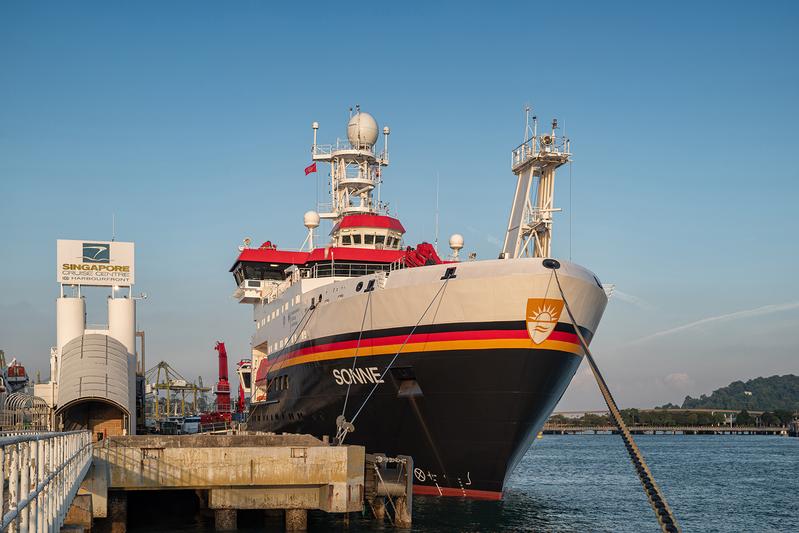Microplastics, estrogens & Co: Ship expedition for the first time investigates “new” pollutants in the Indian Ocean
On July 16, 2024, the German research vessel SONNE starts a three-week expedition to previously little-studied regions of the Indian Ocean between Singapore and Mauritius under the lead of the Leibniz Institute for Baltic Sea Research Warnemünde (IOW). The aim is to determine the extent of human-induced environmental stress and, for the first time, to enable a risk assessment for this region. Newly emerging pollutants such as microplastics, artificial estrogens and polycyclic aromatic hydrocarbons are in focus. The expedition is funded by the German Federal Ministry of Education and Research and is recognised as an activity of the UN Decade of the Oceans.
More than half of the world’s population of 8 billion people lives in cities, a trend that is on the rise. These urban agglomerations, which only make up a very small fraction (3%) of the global land area, are causing massive environmental pollution of inland waters and oceans due to the changing lifestyles of the people living there as well as the intensive industrial production and agriculture in the immediate vicinity. The project E-POLIO (short for Emerging POLlutants and Microplastic Abundance in Surface Waters of Indian Ocean), which includes the Indian Ocean expedition SO305/2 with the research vessel SONNE, focuses on emerging pollutants that are characteristic for such agglomerations and have four main features in common: increasing concentrations in the environment, distribution over wide areas and an ongoing accumulation and long residence time in marine ecosystems.
“The study area that we are covering with our expedition and for which we want to enable a risk assessment for newly emerging pollutants for the first time is ideal for our purposes: It covers almost the entire Indian Ocean – stretching from the densely populated regions of Indonesia, Malaysia and Singapore to the remote regions of the open ocean. This allows us to gain a better understanding of the far-reaching influence of megacities and thus the land-coast-ocean interaction in a very sensitive marine ecosystem,” says Joanna Waniek, the expedition’s chief scientist and deputy head of the Marine Chemistry Section at the IOW.
Along the 6300 kilometre-long route, extensive sampling of the surface water and deeper water layers will be carried out to investigate pollutants such as microplastics, artificial oestrogens with extremely harmful hormonal environmental effects, and organic micropollutants like carcinogenic polycyclic aromatic hydrocarbons and perfluorinated and polyfluorinated alkyl compounds. This will be supplemented by air sampling using on-deck high-volume air samplers. Additional biochemical and hydrographic measurements will be used to characterise different water masses and to investigate large-scale currents and exchange processes. Furthermore, the expedition aims at gaining a deeper understanding of the nitrogen cycle in the central equatorial and southern Indian Ocean, as this is also influenced by human activities, with too high anthropogenic nitrogen loads disrupting such sensitive ecosystems through over-fertilisation.
“Such extensive sampling that allows us to trace the transport pathways of anthropogenic pollutants both horizontally – I.e. from land to the open ocean – and vertically – from the water surface to deeper water layers – has never been done before in the Indian Ocean. Alongside the assessment of the environmental risk posed by new pollutants in the study area, we also hope to gain general insights into their transport mechanisms and their fate in the environment, which can be applied as models to other marine regions,” says expedition leader Waniek.
A total of 27 researchers are taking part in the SO305/2 expedition, of which 15 are from the IOW. In addition, scientists from the Helmholtz Centre Hereon and the Institute of Geology at Hamburg University participate in the E-POLIO project.
The expedition is a recognised contribution to the activities of the United Nations Decade of the Ocean (https://oceandecade.org). Launched in 2021, this global campaign aims to achieve a sustainable future for the ocean by developing and implementing science-based solutions to the most pressing problems. As the SONNE expedition provides the first assessment of Indian Ocean pollution for the entire ocean basin, it specifically supports the following goals of the UN Ocean Decade (https://ozeandekade.de/en/un-ozeandekade/): Clean Ocean (1), Healthy and Resilient Ocean (2), and Predictable Ocean (4).
Expedition SO305/2 ends on August 5 in Port Louis, Mauritius.
IOW Media contact: presse@io-warnemuende.de
Dr. Kristin Beck, Tel.: +49 (0)381 – 5197 135 | Dr. Matthias Premke-Kraus, Tel.: +49 (0)381 – 5197 102
The IOW is a member of the Leibniz Association that connects 96 independent research institutions that range in focus from natural, engineering and environmental sciences to economics, spatial and social sciences and the humanities. The institutes are jointly financed at the state and national levels. The Leibniz Institutes employ a total of 20,500 people, of whom 11,500 are scientists. The total budget of the institutes is 2 billion Euros. www.leibniz-association.eu
Wissenschaftlicher Ansprechpartner:
Prof. Dr. Joanna Waniek | Deputy Head of the Marine Chemistry Section at the IOW &
Head of the IOW working group Biophysical Interactions
joanna.waniek@io-warnemuende.de | Tel.: +49 (0)381 5197 300
Die semantisch ähnlichsten Pressemitteilungen im idw



